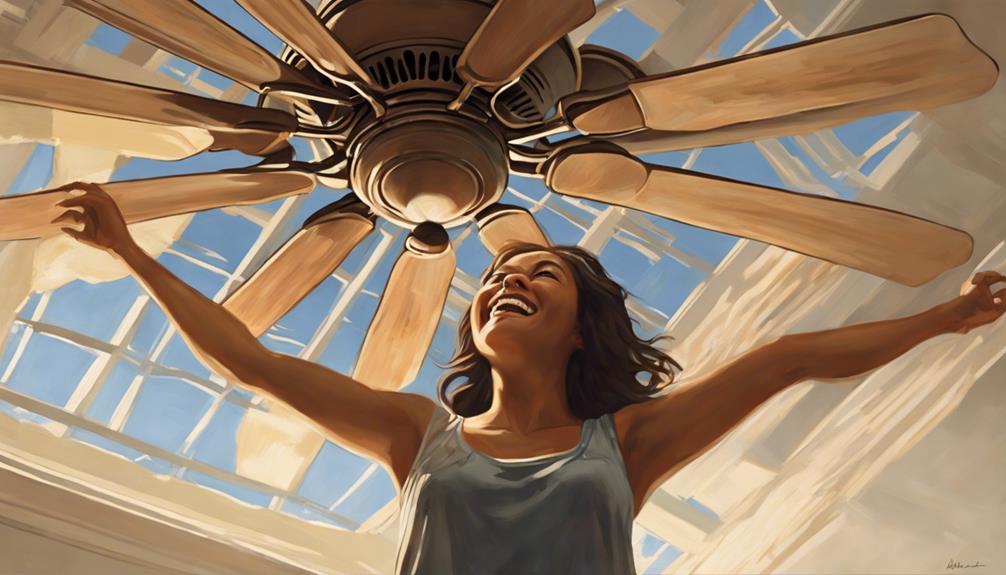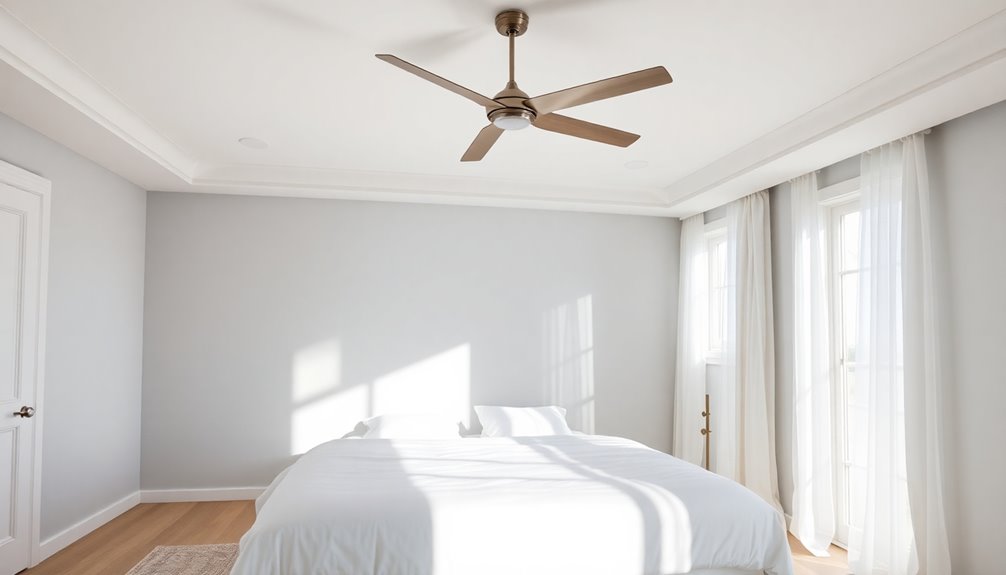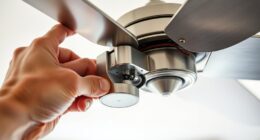Ceiling fans are a great way to keep your home cool and comfortable. They provide an energy-efficient solution for air circulation. Have you ever wondered why some fans seem to work better than others? The secret lies in something called blade pitch. This is a crucial factor that greatly influences a fan’s performance. Let’s explore what blade pitch is, how it affects your fan’s performance, and why it matters when choosing a ceiling fan for your space. Blade pitch refers to the angle of the fan blades in relation to the flat horizontal plane, and it determines how effectively air is moved throughout the room. Fans with a steeper blade pitch are generally more efficient at circulating air, as they can move larger volumes of it with each rotation. When comparing fans, it’s worth noting differences between us and Indian ceiling fan blades, as regional designs and preferences may impact their blade angles and overall performance.
Key Points on Ceiling Fan Blade Pitch
- Blade pitch is the angle of fan blades compared to the ground
- Typical blade pitch range is 10-15 degrees
- Higher pitch moves more air but needs more power
- Lower pitch moves less air and uses less power
- Optimal pitch balances airflow, efficiency, and noise
- For small rooms, 12-14 degree pitch is recommended
- For large rooms, 14-16 degree pitch is recommended


1. What is Fan Blade Pitch?
Most ceiling fans have a blade pitch between 10 and 15 degrees. This range is usually just right for moving air in your home without making too much noise or using too much power. The pitch affects not only the amount of air moved but also the fan’s energy consumption, noise level, and overall performance. Experts in fan design have found that this range offers the best balance between airflow and energy efficiency for most homes. Learn more about how blade pitch affects your fan’s performance, including detailed insights into the science behind air movement and fan blade design.
Fan blade pitch is the angle of the fan blades compared to the ground. Think of it like a ramp – the steeper the angle, the more air the blade can push. This angle is super important because it decides how well a ceiling fan moves air and makes your room feel comfy. The pitch of a fan blade is measured in degrees and plays a crucial role in determining the fan’s overall efficiency and effectiveness in circulating air throughout a space.
2. How Blade Pitch Affects Airflow
The steeper the blade pitch, the more air your fan can move. But it’s not as simple as making the pitch as steep as possible. A higher pitch also means the fan’s motor has to work harder. This can lead to more noise and higher energy bills if not balanced right. The relationship between blade pitch and airflow is complex and involves several factors:
1. Air Displacement: A steeper pitch allows the blade to “scoop” more air with each rotation, potentially increasing the volume of air moved.
2. Motor Strain: Higher pitches require more torque from the motor, which can affect the fan’s longevity and energy consumption.
3. Turbulence: Very steep pitches can create turbulence, which might actually reduce effective airflow and increase noise levels.
4. Speed Limitations: Fans with steeper pitches might need to operate at lower speeds to maintain efficiency and reduce noise, potentially limiting their maximum airflow capacity.
3. Finding the Right Pitch for Your Room
The best blade pitch can change depending on how big your room is. For smaller spaces, a pitch of 12-14 degrees often works well. If you have a bigger room, you might want a fan with a steeper pitch of 14-16 degrees to make sure the air moves around enough. The optimal pitch for a room depends on several factors:
1. Ceiling Height: Higher ceilings may benefit from steeper pitches to ensure air reaches lower levels effectively.
2. Room Size: Larger rooms typically require fans with higher pitches to circulate air throughout the space.
3. Furniture Layout: The arrangement of furniture can affect airflow, potentially influencing the ideal blade pitch.
4. Insulation: Well-insulated rooms might require less aggressive air movement, allowing for a lower pitch.


When picking a fan, think about how big your room is and how much air you want to move. Consider factors such as the room’s main use, how many people are usually in it, and any specific cooling needs. For example, a bedroom might need a fan with a moderate pitch for quiet operation, while a living room might need a higher pitch for more air circulation. Check out our guide on choosing the right fan for your space, which includes detailed recommendations based on room size, ceiling height, and intended use.
4. Blade Pitch and Energy Efficiency
While a steeper pitch can move more air, it also needs more energy. It’s important to find a balance between how well the fan works and how much it costs to run. A fan with the right pitch for your room can keep you cool without making your electricity bills too high. Energy efficiency in ceiling fans involves several factors:
1. Motor Efficiency: Higher pitches require more powerful motors, which can be less energy-efficient if not properly designed.
2. Blade Design: The shape and material of the blades can affect how efficiently they move air at different pitches.
3. Speed Settings: Fans with variable speeds can operate more efficiently by allowing users to adjust airflow based on needs.
4. Room Insulation: Well-insulated rooms may require less aggressive fan operation, potentially saving energy.
When thinking about energy efficiency, it’s important to look at the fan’s overall design, not just the blade pitch. Some manufacturers have created innovative blade shapes and materials that can move air efficiently even at lower pitches, using less energy without sacrificing performance.
5. Blade Pitch and Fan Noise
The angle of your fan’s blades can also affect how noisy it is. Fans with a very steep pitch might move a lot of air, but they can also be louder. If you’re looking for a quiet fan, especially for a bedroom, you might want to choose one with a moderate pitch that balances airflow and noise levels. The relationship between blade pitch and noise is influenced by several factors:
1. Air Turbulence: Steeper pitches can create more turbulence, leading to increased noise levels.
2. Motor Strain: Higher pitches require more power from the motor, which can result in additional operational noise.
3. Blade Design: The shape and material of the blades can affect how quietly they move through the air at different pitches.
4. Speed Settings: Fans with multiple speed settings allow users to find the optimal balance between airflow and noise for different situations.
Learn more about how blade pitch affects fan noise, including tips on selecting quiet fans for noise-sensitive areas and understanding noise ratings for ceiling fans.
6. Adjustable Pitch Fans: A Flexible Option
Some ceiling fans let you change the blade pitch yourself. These adjustable fans are great because you can customize the airflow based on what you need. For example, you might want more air movement on a hot day, but less when it’s cooler. Adjustable pitch fans offer several advantages:
1. Seasonal Adaptability: You can optimize the fan for both summer cooling and winter air circulation.
2. Room Versatility: The same fan can be adjusted to suit different room sizes or purposes.
3. Energy Optimization: Users can find the most energy-efficient setting for their specific needs.
4. Noise Control: The pitch can be adjusted to minimize noise when necessary, such as in bedrooms or study areas.

7. Blade Pitch for Different Seasons

Did you know that the best blade pitch can change with the seasons? In summer, a steeper pitch can help create a stronger cooling breeze. In winter, a gentler pitch can help circulate warm air without creating a chilly draft. Seasonal considerations for blade pitch include:
1. Summer Cooling: Steeper pitches can create a more noticeable “wind chill” effect, enhancing cooling.
2. Winter Circulation: Lower pitches can help gently push warm air down without creating uncomfortable drafts.
3. Energy Savings: Adjusting pitch seasonally can optimize energy usage year-round.
4. Comfort Customization: The ability to change pitch allows for fine-tuning comfort levels in different weather conditions.
Many fans have a switch that changes the direction they spin. This, combined with adjusting the blade pitch or speed, can help you stay comfortable all year round. By reversing the fan’s direction in winter and using a lower pitch, you can help distribute warm air that naturally rises to the ceiling, potentially reducing heating costs. Learn more about using your ceiling fan effectively in different seasons, including tips on optimal settings for both cooling and warming effects.
8. Blade Pitch in Industrial vs. Residential Fans
Industrial ceiling fans often have a different blade pitch than the fans you’d find in homes. They’re designed to move a lot more air in bigger spaces like warehouses or gyms. These fans might have a steeper pitch, sometimes up to 25 degrees, to push air through large areas. The differences between industrial and residential fans extend beyond just blade pitch:
1. Size and Scale: Industrial fans are typically much larger, with longer blades to cover more area.
2. Motor Power: Industrial fans have more powerful motors to support the higher pitch and larger size.
3. Airflow Requirements: Industrial spaces often need more aggressive air movement for comfort and functionality.
4. Noise Considerations: Industrial settings can often tolerate higher noise levels than residential areas.
5. Energy Efficiency: Despite their size, many industrial fans are designed for high efficiency to manage operating costs in large spaces.
Low Pitch, Few Blades
Moderate airflow, energy-efficient
High Pitch, Few Blades
High airflow, potentially noisy
Low Pitch, Many Blades
Smooth operation, moderate airflow
High Pitch, Many Blades
Maximum airflow, higher energy use
9. The Role of Motor Power in Blade Pitch
A fan’s motor needs to be strong enough to support its blade pitch. If the pitch is too steep for the motor, the fan won’t work well and might wear out faster. When choosing a fan, it’s important to look at both the blade pitch and the motor power to make sure they work well together. The relationship between motor power and blade pitch involves several key factors:
1. Torque Requirements: Steeper pitches require more torque from the motor to maintain optimal rotation speed.
2. Energy Efficiency: A well-matched motor and blade pitch combination can operate more efficiently, reducing energy consumption.
3. Performance Consistency: A motor with sufficient power for the blade pitch will maintain consistent performance over time.
4. Longevity: Motors that are appropriately sized for the blade pitch tend to have a longer operational life.
5. Noise Levels: A motor struggling to power blades with too steep a pitch may produce more noise.


Conclusion: Choosing the Right Fan Blade Pitch
Understanding fan blade pitch can help you choose the best ceiling fan for your needs. Remember, the right pitch depends on your room size, how much air you want to move, and how much energy you’re willing to use. A fan with a good blade pitch will keep you cool and comfortable without making too much noise or costing too much to run. Consider factors such as the fan’s intended use, the size of the space, and your personal preferences for airflow and noise levels.
When shopping for a new ceiling fan, look for one with a pitch between 12 and 15 degrees for most rooms. This range typically offers the best balance of airflow, energy efficiency, and noise levels for residential use. If you have a large space or need more airflow, you might want to go for a steeper pitch, potentially up to 16 or 18 degrees. And don’t forget to consider adjustable pitch fans for the most flexibility, allowing you to customize your fan’s performance based on changing needs or seasons.
With the right blade pitch, your ceiling fan can be a powerful tool for keeping your home comfortable all year round, potentially reducing your reliance on air conditioning and helping to lower energy costs. When selecting a fan, also consider other factors such as blade material, motor quality, and overall design to ensure you get a fan that not only performs well but also looks good in your home. Check out our selection of ceiling fans to find the perfect one for your home, featuring a range of options to suit various room sizes, styles, and performance needs.







